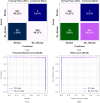Enhancing neurological disease diagnostics: fusion of deep transfer learning with optimization algorithm for acute brain stroke prediction using facial images
- PMID: 40210979
- PMCID: PMC11985909
- DOI: 10.1038/s41598-025-97034-y
Enhancing neurological disease diagnostics: fusion of deep transfer learning with optimization algorithm for acute brain stroke prediction using facial images
Abstract
Stroke is a main risk to life and fitness in current society, particularly in the aging population. Also, the stroke is recognized as a cerebrovascular accident. It contains a nervous illness, which can result from haemorrhage or ischemia of the brain veins, and regular mains to assorted motor and cognitive damages that cooperate with functionality. Screening for stroke comprises physical examination, history taking, and valuation of risk features like age or certain cardiovascular illnesses. Symptoms and signs of stroke include facial weakness. Even though computed tomography (CT) and magnetic resonance imaging (MRI) are standard diagnosis techniques, artificial intelligence (AI) systems have been constructed based on these methods, which deliver fast detection. AI is gaining high attention and is being combined into numerous areas with medicine to enhance the accuracy of analysis and the quality of patient care. This paper proposes an enhancing neurological disease diagnostics fusion of transfer learning for acute brain stroke prediction using facial images (ENDDFTL-ABSPFI) method. The proposed ENDDFTL-ABSPFI method aims to enhance brain stroke detection and classification models using facial imaging. Initially, the image pre-processing stage applies the fuzzy-based median filter (FMF) model to eliminate the noise in input image data. Furthermore, fusion models such as Inception-V3 and EfficientNet-B0 perform the feature extraction. Moreover, the hybrid of convolutional neural network and bidirectional long short-term memory (CNN-BiLSTM) model is employed for the brain stroke classification process. Finally, the multi-objective sailfish optimization (MOSFO)-based hyperparameter selection process is carried out to optimize the classification outcomes of the CNN-BiLSTM model. The simulation validation of the ENDDFTL-ABSPFI technique is investigated under the Kaggle dataset concerning various measures. The comparative evaluation of the ENDDFTL-ABSPFI technique portrayed a superior accuracy value of 98.60% over existing methods.
Keywords: Acute brain stroke prediction; Facial images; Fusion of transfer learning; Image pre-processing; Optimization algorithm.
© 2025. The Author(s).
Conflict of interest statement
Declarations. Competing interests: The authors declare no competing interests.
Figures














Similar articles
-
An Ensemble of Deep Learning Enabled Brain Stroke Classification Model in Magnetic Resonance Images.J Healthc Eng. 2022 Nov 18;2022:7815434. doi: 10.1155/2022/7815434. eCollection 2022. J Healthc Eng. 2022. PMID: 36437817 Free PMC article.
-
Self-attention-based generative adversarial network optimized with color harmony algorithm for brain tumor classification.Electromagn Biol Med. 2024 Apr 2;43(1-2):31-45. doi: 10.1080/15368378.2024.2312363. Epub 2024 Feb 18. Electromagn Biol Med. 2024. PMID: 38369844
-
Leveraging explainable artificial intelligence with ensemble of deep learning model for dementia prediction to enhance clinical decision support systems.Sci Rep. 2025 May 13;15(1):16639. doi: 10.1038/s41598-025-97102-3. Sci Rep. 2025. PMID: 40360623 Free PMC article.
-
Fusion of transfer learning with nature-inspired dandelion algorithm for autism spectrum disorder detection and classification using facial features.Sci Rep. 2024 Dec 28;14(1):31104. doi: 10.1038/s41598-024-82299-6. Sci Rep. 2024. PMID: 39730903 Free PMC article.
-
Image Features of Magnetic Resonance Angiography under Deep Learning in Exploring the Effect of Comprehensive Rehabilitation Nursing on the Neurological Function Recovery of Patients with Acute Stroke.Contrast Media Mol Imaging. 2021 Sep 10;2021:1197728. doi: 10.1155/2021/1197728. eCollection 2021. Contrast Media Mol Imaging. 2021. PMID: 34602911 Free PMC article.
References
-
- Sirsat, M. S., Fermé, E. & Camara, J. Machine learning for brain stroke: A review. J. Stroke Cerebrovasc. Dis.29(10), 105162 (2020). - PubMed
-
- AL-Nuaimi, B. T., Suhail, R. A. & El-kenawy, E. S. M. Adaptive feature selection based on machine learning algorithms for lung tumors diagnosis and the COVID-19 index. J. Intell. Syst. Internet Things11(2), 24 (2024).
-
- Hilbert, A. et al. Data-efficient deep learning of radiological image data for outcome prediction after endovascular treatment of patients with acute ischemic stroke. Comput. Biol. Med.115, 103516 (2019). - PubMed
MeSH terms
LinkOut - more resources
Full Text Sources
Medical

